
|
|
Rafal T. Prinke - The Great Work in the Theatre of the WorldArticle originally published in A Compendium on the Rosicrucian Vault, ed. by Adam McLean, Edinburgh, 1985, 19-34.THE GREAT WORK IN THE THEATRE OF THE WORLDThe symbolic significance of the Vault of Our Father C.R.C. as described in the Fama Fraternitatis and other supposedly Rosicrucian sources
General RemarksThe Vault of Christian Rosenkreutz, the story of its foundation, later discovery and opening, and its description form the central element of the first published document of the Rosicrucian Order, generally believed to be one of the three "official" publications. The document is of course the Fama Fraternitatis published in Cassel in 1614. The flood of various pamphlets and books on the subject which followed its publication and still continues to be issued by different groups and individuals (either claiming succession to the original authors or analysing the Rosicrucian phenomenon) contains surprisingly little additional information about the Vault and its meaning. Before passing on to the presentation of my own ideas on the subject, however, I would like to devote some space to defining the approaches or angles from which the whole Rosicrucian problem can be (and is) studied. These can be roughly divided into the following groups: 1. Extreme orthodox scholarship: investigations are usually meticulous but are concerned with the facts relating directly to the problem and conclusions are strictly based on them. This attitude is shown especially by German historians such as Hans Schick. 2. Progressive orthodox scholarship: conclusions are drawn from a wider array of facts, also those which seem to have no direct relation to the problem, and far-reaching hypotheses are put forward, but no deeper significance or meaning of them is given. Examples of this attitude may be found in Frances Yates or W.E. Peuckert. 3. Sober esotericism combined with heterodox scholarship: existence of the esoteric tradition is accepted and facts are interpreted in its light but great effort is made to be in agreement with historically proven or provable facts. This attitude can be found in the writings of Arthur Edward Waite, Manly Palmer Hall, and Adam McLean. 4. Far-reaching esotericism: historical facts get a highly sopsophisticated interpretation but they are never contradicted by it, i.e. it is a magical interpretation. The best example of this approach is the work of S.L. MacGregor Mathers. 5. Naive esotericism: new and otherwise unknown "historical facts" are discovered by magical means (reading the Akashic record, communication with the Masters, clairvoyance, etc.) and conclusions are based on them. There are many examples of this attitude, most notably Rudolph Steiner, anthroposophists, theosophists, AMORC ("Echnaton was a Rosicrucian" !), etc. 6. Crazy esotericism: the whole problem is either developed ad absurdum (as in Hargrave Jennings) or is not taken seriously (as in joking remarks by Aleister Crowley). Personally, I believe that the best two ways of approaching the Rosicrucian enigma by an esotericist are the third and the sixth. The value of the former is obvious, while that of the latter lies in the fact that by making nonsense out of the whole thing it enables one to break through the concentional reasoning and get to the "deeper meaning". It is the way somewhat similar to the method of Zen. However, in this essay I will be concerned with the third approach only. For this reason another, more general, differentiation has to be made. In the writings of early Rosicrucian apologists there are various strange "facts" given, which are obviously (for the most part, at least) not "historical facts" but something that can be called "traditional facts". Now, a question arises whether a "sober esotericist" should believe them or not. My point of view is that such facts are to be "believed" but with another kind of "belief". It is the difference between magical thinking and scientific thinking that presents itself here and an esotericist should learn to switch from one to the other without confusing them (as the "naive" esotericists" do). In other words, the "traditional" or "esoteric" facts, such as the events in the life of Christian Rosenkreutz, have their meaning when perceived from one point of view but are a mere fable when examined from the other angle. If we confuse these two ways of looking at the evidence available, we will neither reconstruct the historical facts nor grasp the deeper significance of Rosicrucianism.
Bearing all this in mind, we can attempt to investigate the
subject of the Vault of C.R.C. The first thing to do is to remind
ourselves of the description given in the Fama. So there is a
seven-sided chamber, each wall measuring 5 x 8 feet and divided
into ten squares, with several figures and sentences and also
having a small door for a chest hiding books and other things.
The ceiling is divided into triangle with "another sun" in the
centre, probably also containing inscriptions but this is not
revealed in the Fama. The floor is also a heptagon divided into
triangles and inscribed with something refering to "the inferior
Governors". In the centre there is a round altar with an
inscribed brass plate and apparently another extremely small
altar containing the mysterious "Minutum Mundum" inside it.
Leaving the brass plate on the altar aside for a moment (as it is
comparatively precisely described and I shall return to it
later), the above is all we know about the Vault from the
"official" documents. The description is imprecise enough to be
capable of various intepretations and, therefore to be treated as
an archetype. It is similar to the case of the Tarot cards, and
just as they can (and do) have different representations on the
material plane, so the Vault of C.R.C. can have various models,
all of them being only approximations to the archetypal ideal
(both in form and meaning, both of which are impossible to be
fully explained). In spite of this there is only one
comprehensive model of the Vault, that of the Golden Dawn, and
even very few suggestions concerning some elements of it or
remarks of a general nature in all the numerous books on
Rosicrucians. One of such remarks is the belief (repeated for
instance by Manly Palmer Hall) that the 53rd diagram from
Gregorius von Welling's Opus Mago-Cabbalisticum et Theosophicum
(1735) is a plan of the Vault of Christian Rosenkreutz.

Though interesting, this suggestion is not based on any passage in the book itself (which I have inspected for this purpose). That curious work had a vogue among the 18th century Rosicrucians but it does not mention the Order or its mythical founder in any place. Also the short description of the plate in question (entitled "Schema de Mundo Archetypo") does not refer to any tomb or secret society. This idea must have been started by the book entitled The Rosicrucians written by theosophical authors at the beginning of the 20th century (Paul Allen quotes the relevant passage from it and it is in no way revealing). Therefore it may correspond to the plan of the Vault of C.R.C. only as far as both are "Compendiums of the Universe".

Another model of the Vault is its representation in M.P. Hall's Secret Teachings of All Ages (the plate facing page CXLI painted by A. Knapp). It is as realistic as it could be, following the Fama description in every detail. The main interpretative elements include: the walls divided into nine squares instead of ten, with an additional triangle on the central square; the position of the small door on each wall below the squares, which is logical though the Fama is not precise about it.
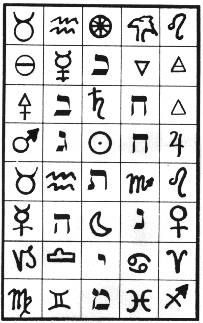
The Golden Dawn model is a much further departure from the Fama: S.L. MacGregor Mathers divided each wall of the Vault into 40 squares, ten of which correspond to the Sephiroth of the Kabbalistic Tree of Life, while others had other symbols (astrological, etc.). There were no "sentences", mentioned by the Fama, and no small doors hiding books and various technical inventions.
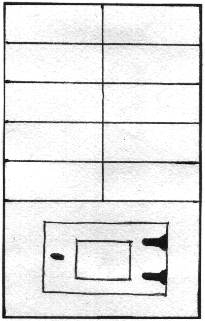
Finally, Adam McLean suggests that the squares on each wall are in two columns of five to incorporate an element of polarity.
I. Numbers and measures of the Vault
Since most authorities on the subject agree that the Vault of
C.R.C. described in the Fama was not intended to represent any
real building (just as the Collegium ad Spiritum Sanctum in which
it was discovered), all its elements have to be regarded as
symbols and will thus be analysed here. First of all we have the
all important number seven (the number of walls and the triangles
on the ceiling and the floor, as well as inherent in the
heptagonal shape of them), the symbolism of which is so extensive
and so well known to anyone interested in the hermetic tradition
that there is no point in presenting it here in detail. I will
just mention its correspondences with the seven planets of astro-
logy, the seven metals of alchemy, the seven days of the week,
etc. It is also interesting to note that heptagons are also quite
common among hermetic sigils or talismans

(the most beautiful example is perhaps John Dee's Sigillum Dei Aemeth) and were also used as plans for symbolic structures (as in Khunrath's Amphitheatrum Sapientiae Aeternae). Besides number seven, which is the most prominent one in the description of the Vault, there are also numbers five and eight, being the width and height of each wall respectively. Again as the whole structure is most probably not real, these must be symbolic. (In fact, even if it were real, the Vault being a "Compendium of the Universe", its measurement would have to be meaningful). Five is another very important number in the magical/hermetic tradition. It is the number of the senses and therefore of the body (also the body of Jesus had five wounds). It is also the number of Man (whose body, with arms and legs extended, can be fitted into the pentagram, as for example on a figure in Agrippa's De Occulta Philosophia) and of Nature (the five elements of Aristotle: earth, water, air, fire and quintessence). It may therefore be considered to symbolise the whole of Creation - the Microcosm/Man and Macrocosm/Nature. 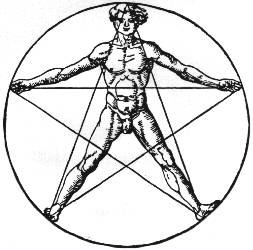
Eight, on the other hand, has always been associated with a new beginning, new life (fonts in churches were often octagonal), resurrection and Christ (the name "Jesus" in Greek has the numerical value of 888). In connection with five it may be interpreted as the new life for humanity or "General Reformation of the Whole World" as the Rosicrucians put it. It does not end here, however, for the two numbers are obviously intended to be multiplied in order to obtain the number referring to the surface of each wall. The number is forty and it is even more meaningful. It appears in the Bible very frequently (being second only to seven) and was sacred to many ancient peoples. Traditionally it is the number of a period of preparation and waiting for regeneration, of purification and sanctification. As such it is often used by Jacob Boehme, which is of special interest here, since this mystic may have had some Rosicrucian connections. In De Tribus Principiis he writes, for example: "So the spirit of Christ rested in Father for forty hours, which it spent in the grave in the presence of the body... these were the same forty hours during which Adam remained asleep, when his woman was made out of him; also those forty days of Moses' ordeal on the mountain". Jewish Kabbalists of the same period regarded forty as the number of perfection, too. W.E. Peuckert in his Pansophia gives a Kabbalistic legend telling that when the archpriest Ezra ordered to write down the secret teachings, including the seventieth book of the Kabbalah, the Sanhedrin deliberated about it for forty days and then decided it could be read by those who were forty years old. Agrippa in his De Occulta Philosophia also devotes some space to this number, stating in conclus ion that it is connected with trial, experience, gaining the state of purity and readiness for a new life. This may have been one of the main influences on later Rosicrucian teachings, as Julius Sperber mentions Agrippa among the forerunners of the Order. Paul Sedir, a French esotericist and Rosicrucian historian, says that "regeneratory mysteries had a numerical key, which was forty" (Histoire et doctrines des Rose-Croix). In alchemy the duration of the Great Work is often defined to be 40 days or 40 weeks. Forty is also connected with birth (and rebirth) because for many centuries it was believed, on the authority of Aristotle, that forty days had to elapse between the conception of a child and the descent of soul into it. The whole time of pregnancy was in fact divided into periods of forty days each and there were seven such periods. Interestingly enough we have the same scheme in the Vault of Christian Rosenkreutz: there are seven walls, each of them having forty (5 x 8) square feet, which gives 280 or the approximate number of days in an average pregnancy. Therefore, the structure may be interpreted as intended for the symbolic process of ripening, growth and finally birth into a new life. It is a regeneratory chamber between death and rebirth of Father C.R.C. symbolically understood as Man (5) and Nature or Christ (8). This interpretation will be confirmed again below. The remaining numerical symbols mentioned in the Fama description of the Vault are 10 and 120. The former is the number of squares on each wall which are most probably connected with the Kabbalistic Sephiroth and I will deal with it later. The latter is the number of years during which the Vault was closed. The meaning of that period is not quite clear but it is not peculiar to the case of Father C.R.C. only. In my article in the Journal of Rosicrucian Studies No. 1, I mentioned the Polish alchemist Wincenty Kowski (Koffski). His treatise Tractatus de prima materia is said to have been bricked up in the wall of his cell in a Dominican monastery in Gdansk in 1488 (the year of his supposed death) and was published after 120 years (in 1608). Also in Simon Studion's prophetic work Naometria, so often associated with the early phase of Rosicrucianism, the period of 120 years figures prominently as "Candlestick period" (c.f. Adam McLean's article in The Hermetic Journal No. 19). It is interesting that the figure in which that period is found consists of seven candlesticks, each having forty nodes, thus corresponding to the seven wall of the Vault of C.R.C. of forty square feet each. The symbolic meaning of 120 years is not obvious. Most probably it is an extension of 12, the number of the signs of the Zodiac and therefore of the completion of a cycle of experience. If so, then it may be noted that in Hindu astrology 120 years is considered to be the natural length of human life. Before finishing the analysis of numerological symbolism in the Vault of C.R.C. I would like to mention one more Kabbalistic correspondence. The number of the walls and the triangles on the ceiling and the floor totals 21 (3 x 7) and treating the artificial sun in the middle of the ceiling as an element of the same category, we have 22 elements which is the number of letters in the Hebrew alphabet and the Paths on the Tree of Life.
II. The Theatre of the World and the Time Capsule.The richness of numerical symbolism in the description of the Vault of Christian Rosenkreutz clearly indicates that the author or authors of the Fama intended it to be read as a symbolic, carefully constructed puzzle. However, the numerology itself does not tell us much about the possible application of the structure. In my opinion the key to understanding the actual meaning of the design of the Vault is the sentence from the Fama stating that "if it should happen after many hundred years, the Order or Fraternity should come to nothing, that they might by this one Vault be restored again". It implies in no uncertain terms that the hermetic art of memory should be considered in analysing the description of the Vault. An additional clue is the fact that the work published together with the Fama (or rather, to which the Fama was appended) was The General Reformation of the Whole World which was a translation of a fragment from Ragguagli di Parnasso by Traiano Boccalini. As it was translated by Wilhelm Bidembach, a member of "The Tubingen Circle" and a friend of Johann Valentin Andreae, there seems to have been a direct and close connection of the first Rosicrucians with the Italian hermetic circles. Now, the most famous example of applied Ars Memoriae in 16th century Italy was the Memory Theatre of Giulio Camillo. It was still well known among the "Brunonian" hermetists of Italy at the turn of the centuries and that is, I believe, the source where the original ideas for the design of the Rosicrucian Vault should be looked for. It would probably be going too far if I suggested that Giulio Camillo was the prototype of Christian Rosenkreutz (Frances Yates thought it was John Dee) but it is not impossible. Even the mysterious Liber T may be explained as Liber Theatri which may have been written by Camillo and preserved by his disciples (Liber M, translated by C.R.C., may have been Liber Memoriae). The Theatre of Camillo is described in considerable detail in The Art of Memory by Frances Yates so I will only point to some of the most striking parallels between the two constructions:
Camillo's Theatre of Memory Rosicrucian Vault of C.R.C. 1) 7 passages with seven steps 1) 7 walls with ten squares with on each, surrounding the gates on each, surrounding the central "stage", central altar, There are many other, less obvious, similarities, all of which make it possible to reconstruct the Vault of Christian Rosenkreutz seen as a theatre of magical memory. In both cases the central place is occupied by the operator (on the stage of the Theatre and at the central altar of the Vault) who thus has the whole of the Universe, the Macro- and Microcosm, at his command. Around the stage of Camillo's Theatre there are "Seven Pillars of Solomon's Temple of Wisdom" representing the archetypal Ideas (in the Platonic sense) or the Seven Measures of everything or the Seven Rulers created by the Demiurge. In the Vault of C.R.C. the same basic principles underlying all creation (which are also identical with the Seven Spirits of God mentioned by Boehme in the Aurora) are represented by the seven triangles on the ceiling "running from the seven sides to the bright light in the centre", while the light itself stands for the Demiurge and the fuel that never runs out is the eternal God, the En Soph of the Kabbalists. The difference between the two structures in this respect is that in Camillo's Theatre the operator is placed in the position of God and acts as if he were omnipotent and could influence any part of the Universe by his divine will. The Rosicrucian concept is slightly altered and the operator in the Vault has to draw down the same divine powers into himself in order to use them.
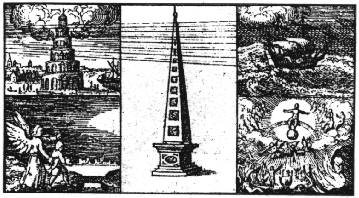
Each passage of the Theatre of Camillo was assigned to one "Measure" or planetary principle, while each step represented succeeding stages of creation, so that any given door or gate contained images refering to one stage of creation in one of the Measures. Although Camillo listed the correspondences between the planets and the Sephiroth, it is clear that the latter are represented rather by the steps of the Theatre (stages of creation or emanations) than by the passages. Therefore each passage can be seen as the Tree of Life of one planetary principle (or emanated by one of Boehme's Spirits of God) just as in the Kabbalah each Sephira is said to contain the whole Tree of Life. He also states that he does not go beyond the seventh Sephira and therefore does not use the Supernal Triangle of the Tree. The Rosicrucian authors of the Fama expanded this arrangement to include all the Sephiroth, represented by the squares of each wall in the usual sequence from Kether above to Malkuth (unlike in Camillo's scheme, where the creative emanations proceeded from the centre upwards). The actual pattern of the squares is not known from the brief description of the Vault but it is quite possible that the pattern later used by Robert Fludd in his Ars Memoriae was applied. Fludd may have been a Rosicrucian and therefore his statement that groups of five images are the easiest to remember should not be ignored in this context. Fludd does not explain the fivefold emblem on the title page of his work, which makes it even more mysterious. It is also in agreement with Adam McLean's suggestion that there may have been two groups of five emblems stressing the element of polarity.

The nature of the "figures and sentences" on the squares is again not clear from the Fama description but these must have been emblems with mottoes similar to those appearing in Camillo's Theatre. The popularity of such emblems (not only in the hermetic context) in the 16th and 17th centuries confirms this hypothesis, and as those of them which are usually associated with Rosicrucianism are alchemical in nature, I tend to suppose that such should also be the "figures" on the walls of the Vault of Christian Rosenkreutz. In an attempt to restore the Vault we have no other choice but to find a suitable set of seventy emblems with mottoes in any Rosicrucian/alchemical work. I have found such a set of exactly seventy figures (with two additional ones, to be honest, but these are unnumbered) described in In the Pronaos of the Temple of Wisdom by Franz Hartmann (pp. 79-81) and taken from the 18th century book August Vindelicorum by Antonio Ginter. Although Hartmann calls them "Rosicrucian symbols" I do not think they are good enough for our purpose. Much better would be a selection from early 17th century Rosicrucian emblems, perhaps from Michael Maier's books, and especially from his Atalanta Fugiens, as they make much use of mythological figures which are also prominent in Camillo's Theatre of Memory. In fact many of Maier's emblems are identical with those of Camillo (as restored by Frances Yates) and he also uses mythological symbolism in his books devoted solely to the Rosicrucian problem, (Silentium Post Clamores, Themis Aurea). It would be interesting to reconstruct the Vault of C.R.C. along these lines, but it is impossible for me at present as I have no access to a complete set of Maier's emblems.

The next common element of both structures are containers for books and other things below the emblems. In the Rosicrucian Vault these were chests behind doors in each wall, while Camillo had special drawers in his Theatre for identical purpose. Finally, there are the seven triangles on the floor of the Vault, in which is described "the power and rule of the Inferior Governors". This element is missing from Camillo's Theatre but it is only a logical completion of polarity with the triangles on the ceiling which represented the Seven Rulers of the superior or heavenly spheres. The "evil serpent" mentioned in the Fama may be included in the design but it may as well be just a figure of speech. To sum up, seen as a Memory Theatre, the Rosicrucian Vault could really play the role of a "Time Capsule" which would transmit the Rosicrucian teachings even if the original Order died out. Other applications of it will be dealt with below.
III. The Altar-Mandala and the Minutum MundiThe round altar that stood in the centre of the Vault is comparatively well described in the Fama. From what we know it is obvious that the brass plate on it was engraved with a mandala-like design, though the exact details are missing. Fortunately, it is not necessary to reconstruct it, as I have found an early 17th century illustration which depicts the altar plate. It comes from a book entitled Raphael by Abraham von Franckenberg, a Pansophist and Rosicrucian from Wroclaw in Silesia (at that time belonging to the Kingdom of Bohemia). This beautiful mandala is too complex to analyse it in detail here (it deserves a separate article), so I will only point to the elements corresponding to the Fama description or otherwise relating directly to the Rosicrucian issue.
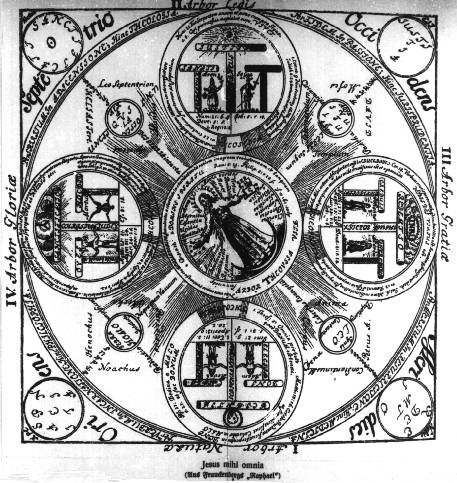
The title of the whole illustration is "Jesus mihi omnia" but this sentence does not appear on the design itself, though in the Fama it is said to have been written "around the first Circle or Brim". The four sentences "A vacuum exists nowhere", "The Yoke of the Law", "The Liberty of the Gospel" and the "Entire Glory of God" appear on the arms of the central cross, which seems to be glowing. Between the arms of that cross there are four big circles with three Tau-crosses and two human figures in each, which may be taken to represent petals and thus completing a schematic Rosy Cross symbol together with the central circle.
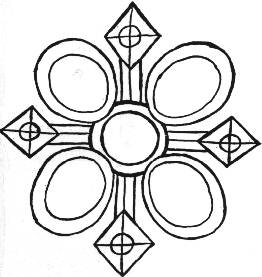
There are also four smaller circles at the end of each arm of the cross as well as four other circles outside the border of the main one corresponding to the four directions (these, I suppose, were to appear on the postument of the altar). All these elements contain many correspondences, quotations from the Bible, names from Biblical history, religious terminology, etc. The most interesting for the present purpose is, however, the central circle with the figure of Christ in it. This figure bears a certain resemblance to Christian Rosencreutz in his grave as described in the Fama. In his left hand he holds an open book with seven seals and with the letters Alpha and Omega, which may be identified with the Liber T. His right hand is surrounded by seven stars which are obviously symbolic of the seven planetary principles or Seven Measures of the created Universe, and therefore denote his mastery over the whole world. A sprout or branch extends from the right side of his breast and this reminds us of that mysterious statement from Liber T quoted in the Fama: "A Grain buried in the Breast of Jesus". On the other side of Christ's breast there is a small four-petalled flower, most probably a rose, while in the middle a black cross can be seen. All this indicates the Rosicrucian nature of this illustration and its connection with the brass plate on the altar in the Vault. Of course, as always, one cannot be sure that von Franckenberg was a genuine Rosicrucian and had access to the original design (if such had ever existed), but still it is the best (if not the only) representation of it of such an early date. The design seems to picture the tradition, and mostly the Christian religious tradition and teachings, and therefore is in accord with what we know about the altar plate from the Fama. The other smaller altar containing the mysterious Minutum Mundum (or Minutus Mundus as Waite has it) seems to have been placed in the grave of C.R.C. beneath the altar. Little can be said about it besides that it was some kind of divinatory device and a miniature of the Macrocosm. Perhaps it was a very precise astrolabium, showing the movements of the heavenly bodies for any time in the past, present and future. In that case the divination would be astrological, but it also may have been a "fortune-telling machine" like the Prognometer constructed a few centuries later by Jozef Maria Hoene-Wronski, the Polish Messianist. Some occultists also see a deck of the Tarot cards in it.
IV The Athanor of RegenerationFrances Yates in The Rosicrucian Enlightenment says that Rosicrucianism was the continuation of the earlier hermetic-kabbalistic tradition which reached a new level by assimilating the doctrines and symbols of alchemy. Therefore Rosicrucianism may be looked upon as the final bringing together of all the currents making up the Western Esoteric Tradition: hermetic gnosis and magic, Christian adaptation of the Jewish Kabbalah and alchemical lore. In the symbolic description of the Vault of Christian Rosenkreutz the hermetic and Kabbalistic parts of that tradition were seen in treating the structure as a "Memory Theatre" and in analysing its numerological symbolism, so we now have to find the alchemical element in it. John Heydon, as quoted by Manly Palmer Hall, says that Rosicrucian adepts after having spent a certain period of time among people, were buried in "a proper womb" or the philosophical egg, in which they underwent the process of rejuvenation. Then again after some time they broke the shells of their eggs and came forth for a new round in the world. This symbolic account may suggest a kind of initiatory process of spiritual or inner alchemy going on in the Tomb of Christian Rosenkreutz, in which he is the Materia Prima (this view is supported also by the numerical symbolism outlined above).

When we imagine a cross section of the whole Vault then a kind of Athanor appears. The grave in the bottom part is the alchemical retort or philosophical egg buried in the earth or sand, its neck extending into the main chamber above as the altar and hermetically sealed with the brass plate. The artificial sun on the ceiling is the source of light or heat (as now used in growing chickens). This form of heating the retort in the sand for a long period of time was called igne aperto by the alchemists. The duration of the Great Work was often expressed symbolically as 12 days, 12 months or 12 years, so the 120 years in the case of the Rosicrucian self-transmutation or bringing oneself to the perfect state of the Philosophers' Stone is no surprise. On another level this can be seen as the Great Work going on in the Theatre of the World in order to obtain the Philosophers' Stone with which the General Transformation of the Whole World could be accomplished.
V The Vault of C.R.C. in Esoteric Workings.As I have already said, the structure described in the Fama was most probably not a real building but a symbolic internal construction intended for visualisation, meditation and final self-initiation. It is a complex mandala extended in space which has to be "worked" (in the occult sense). The actual application of it in esoteric practice will demand the following preparations: 1) Drawing the walls, ceiling and floor of the Vault with all the emblems and mottoes on paper. 2) Memorising then so well that they can be easily visualised, both separately and as a seven-sided chamber. 3) Preparing (writing down) meditations, invocations or evocations based on the succession of emblems and memorising them with the help of the emblems (the technique of the traditional art of memory described by Frances Yates). The various operations that now can be performed include for example: 1) Operations of ritual hermetic magic. The invocations and evocations are mnemonically related to the emblems on one or more of the walls (depending on the planetary nature of the operation) and then recited with simultaneous visualisation of the emblems. This technique as applied by Giulio Camillo is described in Frances Yates' book The Art of Memory. 2) Astral Workings. This is similar to "pathworking" in the Golden Dawn tradition: every wall of the Vault can be worked upon either from the light on the ceiling downwards or from the Infernal Triangles on the floor upwards. The emblems can also be used in the way similar to the Tarot cards for entering the Astral Plane. 3) Ritual of Self-Transmutation. The whole Vault is visualised strongly with oneself inside the grave seen as the philosophical egg. A slight heat is felt as coming from above. After practicising this for a considerable period of time the body should pass through various colours in the usual alchemical succession from black to red. 4) The Ritual of Universal Reformation of the Whole World. Similarly to the above, the Vault/Athanor is visualised but inside the grave/retort the world or humanity is placed under a suitable symbol. Then it passes through the successive colours from the black state of putrefaction it is in at present to the red colour of perfection. The astral forces liberated in this way will finally complete the Great Work started by the first Rosicrucians. Bibliography:
1) Allen, Paul (ed.): A Christian Rosenkreutz Anthology,
Blauvert, New York, 1968. |